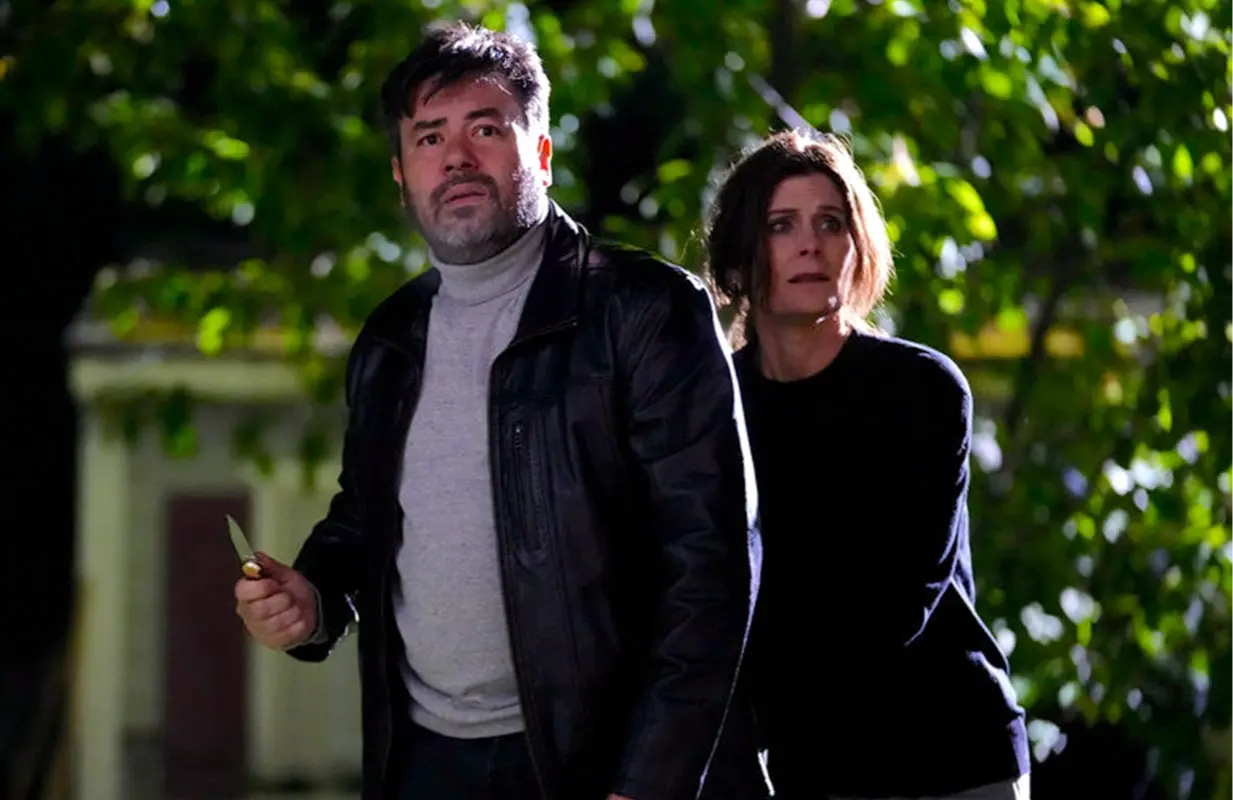Only Some of John Carpenter's Suburban Screams Will Keep You Up at Night
-
 Still from the "Phone Stalker" episode of Suburban Screams (Photo: Gabriel Kuchta/Peacock)
Still from the "Phone Stalker" episode of Suburban Screams (Photo: Gabriel Kuchta/Peacock)John Carpenter is a master of horror — the man practically invented the slasher subgenre with 1978’s Halloween (with a big assist from Texas Chain Saw Massacre and Peeping Tom). His remake of The Thing in 1982 is still regularly cited as one of the most terrifying films of all time. Not to mention the fact that he went on to make In the Mouth of Madness, They Live, and Christine. If we ignore his 1998 film Vampires (and we really should ignore it), Carpenter has one of the most pristine cinematic records for churning out terrifying horror time and time again.
But aside from a couple of episodes of Masters of Horror, this king of darkness has not stepped his toes into television or episodic series until this month’s Peacock release, John Carpenter's Suburban Screams. Rather than approaching his horror anthology series as a straight fiction story in installments, like American Horror Story, Slasher, or Castle Rock, Carpenter takes Suburban Screams into the non-fiction realm. Each episode features a fully-contained “true” story, as told by someone directly involved with the real-life incident. The nature of each episode varies wildly from one to the next, and aside from the talking-head format and dramatic recreations, there is little thematic consistency across the series.
These dramatic recreations are one of the major contributors to the uneven quality of the show. Though Carpenter is a big name in horror, the actors pulled into Suburban Screams are not exactly recognizable. And while that isn’t necessarily an indicator of talent, there are no breakout performances in any of the episodes. Most of the performers are serviceable and transactional in their scenes at best. The whole vibe of these recreations is quite similar to the original seasons of Unsolved Mysteries. Though it has no Robert Stack, no trench coat, nor a way to contact the show if we have any tips to help solve the crimes, Suburban Screams is stuck in the same quality bracket as that vintage mystery gem.
Luckily, Suburban Screams does shine during the interviews of the non-performers who are just telling their stories. In fact, the two episodes in which the interviews feature more prominently than the recreations (“A Killer Comes Home” and “Bunny Man”) are both tense, unpredictable, and riveting. Even the weaker episodes (“Kelly” and “Cursed Neighborhood”) are buoyed entirely by the emotion and clarity imparted by the people who really lived these nightmares.
The nature of the individual stories dials up — or down — the intrigue of each episode. Horror has never been relegated to a strictly fantastical or reality-based bucket. Though all of these stories are based on someone’s actual experience, the tension between reality and unproven phenomena ultimately weakens certain stories in the series. For instance, a real-life killer escaping prison and then taunting the town he used as his killing ground is downright terrifying. But a man getting freaked out by what a Ouija board tells him is a bit harder to get excited about in comparison. Were it not for the promised realism behind the stories in Suburban Screams, that conflict to suspend disbelief would be much less of an issue.
Unsurprisingly, the best episodes also deal with the more fact-based horrors. “A Killer Comes Home” tells the story of a hometown murderer and his vendetta against the newspaper reporter who documented his crimes and trial. The killer escapes prison and comes back to that town and terrorizes them all over again. The episode has the added benefit of this reporter telling his own story, and being able to tell it quite well. Here, there is the face of a man whose life was at risk, and he is telling his first-hand account right to the camera. Though the episode smartly focuses on the reporter as a storyteller, the archival support adds much to the real feel of these crimes. It's truly scary stuff.
“Bunny Man” is another exemplary episode which focuses on an urban legend in Fairfax, Virginia: Over a hundred years ago, a man, dressed in a bunny costume, killed and hung children under a local bridge. The whispered tales of this costumed creep continued on through modern times. However, when suburban sprawl started to crawl into Fairfax, the Bunny Man was spotted again in the area wielding an ax. As if this weren’t spine-chilling enough, the interviews in this episode are with men who were boys in that area when the Bunny was making a comeback. They could see the ax indentations on nearby developments and even saw him with their own eyes. Again, it is the firsthand accounts of these sightings paired with newspaper clippings that add up to an impressively unsettling experience in Suburban Screams.
The first, six-episode season of John Carpenter’s Suburban Screams is hit or miss. The quality of the episodes sways widely from downright sinister to woefully flat, and the inconsistent source material produces inconsistent scares, which is a surprise coming from one of the granddaddies of horror. Carpenter has done so much better than this.
John Carpenter's Suburban Screams premieres October 13 on Peacock.
Deirdre Crimmins has been a critic for over a decade and is always hopeful the next thing she watches will be her new favorite. You can find her on Twitter at @dedecrim.
TOPICS: John Carpenter's Suburban Screams, Peacock, Unsolved Mysteries, John Carpenter, Horror TV